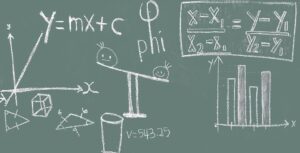Mathematical functions are a fundamental concept in mathematics that describe relationships between sets of values. They are essential for understanding various mathematical operations and solving problems across numerous fields, including science, engineering, and economics. A function assigns each input exactly one output and is used to model relationships and changes in quantities. This article provides an in-depth exploration of mathematical functions, including their definitions, types, properties, and applications.

Mathematical Functions
1. Definition and Basics
What is a Function?
In mathematics, a function is a relation between two sets, called the domain and the codomain. A function assigns exactly one output value for each input value from the domain. Formally, a function \( f \) from a set \( X \) to a set \( Y \) is denoted as \( f: X \to Y \), where each element \( x \in X \) is associated with a unique element \( f(x) \in Y \).
Notation:
– Function Notation: A function is commonly denoted by letters such as \( f \), \( g \), or \( h \). For example, \( f(x) \) represents the output of the function \( f \) for input \( x \).
– Domain and Codomain: The domain is the set of all possible input values, and the codomain is the set of all possible output values. For example, in the function \( f(x) = x^2 \), the domain could be all real numbers, and the codomain is the set of non-negative real numbers.
2. Types of Functions
1. Linear Functions:
A linear function has the form \( f(x) = mx + b \), where \( m \) and \( b \) are constants. The graph of a linear function is a straight line, where \( m \) represents the slope and \( b \) represents the y-intercept.
– Example: \( f(x) = 2x + 3 \) is a linear function with a slope of 2 and a y-intercept of 3.
2. Quadratic Functions:
A quadratic function is of the form \( f(x) = ax^2 + bx + c \), where \( a \), \( b \), and \( c \) are constants, and \( a \neq 0 \). The graph of a quadratic function is a parabola.
– Example: \( f(x) = x^2 – 4x + 4 \) is a quadratic function whose graph is a parabola opening upwards.
3. Polynomial Functions:
Polynomial functions are sums of terms consisting of variables raised to whole-number powers. A polynomial function of degree \( n \) is of the form \( f(x) = a_nx^n + a_{n-1}x^{n-1} + \cdots + a_0 \), where \( a_i \) are constants.
– Example: \( f(x) = 3x^4 – 5x^3 + 2x – 7 \) is a polynomial function of degree 4.
4. Rational Functions:
Rational functions are ratios of two polynomials. They have the form \( f(x) = \frac{p(x)}{q(x)} \), where \( p(x) \) and \( q(x) \) are polynomials, and \( q(x) \neq 0 \).
– Example: \( f(x) = \frac{2x + 1}{x – 3} \) is a rational function.
5. Exponential Functions:
An exponential function has the form \( f(x) = a \cdot b^x \), where \( a \) is a constant and \( b \) is the base of the exponential term.
– Example: \( f(x) = 3 \cdot 2^x \) is an exponential function where the base is 2.
6. Logarithmic Functions:
A logarithmic function is the inverse of an exponential function and has the form \( f(x) = a \cdot \log_b(x) + c \), where \( b \) is the base of the logarithm.
– Example: \( f(x) = \log_2(x) \) is a logarithmic function with base 2.
7. Trigonometric Functions:
Trigonometric functions relate angles to side lengths in right-angled triangles and include sine (\( \sin \)), cosine (\( \cos \)), and tangent (\( \tan \)) functions. They are periodic and have specific properties and graphs.
– Example: \( f(x) = \sin(x) \) is a trigonometric function with a periodic wave-like graph.

3. Properties of Functions
1. Domain and Range:
– Domain: The set of all possible input values for which the function is defined.
– Range: The set of all possible output values the function can produce.
2. Injective (One-to-One) Functions:
A function \( f \) is injective if different inputs produce different outputs. Formally, \( f \) is injective if \( f(x_1) = f(x_2) \) implies \( x_1 = x_2 \).
3. Surjective (Onto) Functions:
A function \( f \) is surjective if every element in the codomain is mapped to by at least one element in the domain. In other words, the function covers the entire codomain.
4. Bijective Functions:
A function \( f \) is bijective if it is both injective and surjective. This means each element in the domain maps to a unique element in the codomain, and every element in the codomain is covered.
5. Inverse Functions:
The inverse of a function \( f \) is denoted \( f^{-1} \) and reverses the mapping of \( f \). If \( f(x) = y \), then \( f^{-1}(y) = x \). For a function to have an inverse, it must be bijective.
4. Graphing Functions
Graphing functions involves plotting the relationship between the input and output values on a coordinate system. The shape and features of the graph provide insights into the function’s behavior, including intercepts, asymptotes, and symmetries.
– Intercepts: Points where the graph intersects the x-axis (x-intercept) or y-axis (y-intercept).
– Asymptotes: Lines that the graph approaches but never intersects.
– Symmetries: Characteristics such as even (symmetric about the y-axis) and odd (symmetric about the origin) functions.

5. Applications of Functions
1. Science and Engineering:
Functions are used to model physical phenomena, such as motion, growth rates, and electrical circuits. For example, exponential functions can model population growth or radioactive decay.
2. Economics:
Functions are employed to analyze and predict economic trends, such as supply and demand, cost functions, and profit maximization.
3. Computer Science:
Functions are essential in algorithms and programming, where they help in creating reusable code and managing data transformations.
4. Statistics:
Functions are used in statistical models to describe data distributions, relationships, and predictions.
Mathematical functions are a cornerstone of mathematics, providing a framework for understanding and analyzing relationships between quantities. By exploring different types of functions, their properties, and applications, we gain valuable insights into various fields of study and real-world problems. Functions enable us to model complex systems, make predictions, and solve equations, making them indispensable tools in both theoretical and practical contexts. Understanding functions and their behaviors enhances our problem-solving abilities and broadens our mathematical knowledge.
See More:
